EMPLOYEES and DEPARTMENTS data: EMPLOYEES DEMP_NAME DEPT_ID MGR_ID JOB_ID SALARY EMPLOYEE_I 101 Smith 20 120 SA_REP 4000 102 Martin 10 105 CLERK 2500 103 Chris 20 120 IT_ADMIN 4200 104 John 30 108 HR_CLERK 2500 105 Diana 30 108 IT_ADMIN 5000 106 Smith 40 110 AD_ASST 3000 108 Jennifer 30 110 HR_DIR 6500 110 Bob 40 EX_DIR 8000 120 Ravi 20 110 SA_DIR 6500 DEPARTMENTS DEPARTMENT_ID DEPARTMENT_NAME 10 Admin 20 Education 30 IT 40 Human Resources On the EMPLOYEES table, EMPLOYEE_ID is the primary key. MGR_ID is the ID managers and refers to the EMPLOYEE_ID. On the DEPARTMENTS table DEPARTMENT_ID is the primary key. Evaluate this UPDATE statement. UPDATE employees SET mgr_id = (SELECT mgr_id FROM employees WHERE dept_id= (SELECT department_id FROM departments WHERE department_name = 'Administration')), Salary = (SELECT salary FROM employees WHERE emp_name = 'Smith') WHERE job_id = 'IT_ADMIN'; What happens when the statement is executed?()
 Which two SQL statements produce the name, department name, and the city of all the employees who earn more then 10000?()
Which two SQL statements produce the name, department name, and the city of all the employees who earn more then 10000?()

Examine the structure of the EMP_DEPT_VU view:
Column Name Type Remarks
EMPLOYEE_ID NUMBER From the EMPLOYEES table
EMP_NAME VARCHAR2(30) From the EMPLOYEES table JOB_ID VARCHAR2(20) From the EMPLOYEES table
SALARY NUMBER From the EMPLOYEES table
DEPARTMENT_ID NUMBER From the DEPARTMENTS table DEPT_NAME VARCHAR2(30) From the DEPARTMENTS table Which SQL statement produces an error?()
Examine the structure of the EMPLOYEES and DEPARTMENTS tables:
EMPLOYEES
EMPLOYEE_ID NUMBER
DEPARTMENT_ID NUMBER
MANAGER_ID NUMBER
LAST_NAME VARCHAR2(25)
DEPARTMENTS
DEPARTMENT_ID NUMBER
MANAGER_ID NUMBER
DEPARTMENT_NAME VARCHAR2(35)
LOCATION_ID NUMBER
You want to create a report displaying employee last names, department names, and locations. Which query should you use to create an equi-join?()
Examine the structure of the EMPLOYEES and DEPARTMENTS tables:
EMPLOYEES
EMPLOYEE_ID NUMBER
DEPARTMENT_ID NUMBER
MANAGER_ID NUMBER
LAST_NAME VARCHAR2(25)
DEPARTMENTS
DEPARTMENT_ID NUMBER
MANAGER_ID NUMBER
DEPARTMENT_NAME VARCHAR2(35)
LOCATION_ID NUMBER
You want to create a report displaying employee last names, department names, and locations. Which query should you use?()
Click the Exhibit button and examine the data in the EMPLOYEES table.
Which three subqueries work? ()
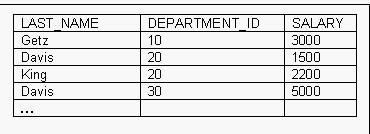
Click the Exhibit button to examine the structures of the EMPLOYEES, DEPARTMENTS, and TAX tables.
For which situation would you use a nonequijoin query?()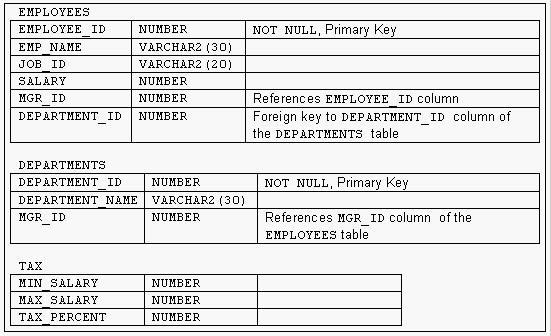
Examine the structure of the EMPLOYEES, DEPARTMENTS, and LOCATIONS tables.
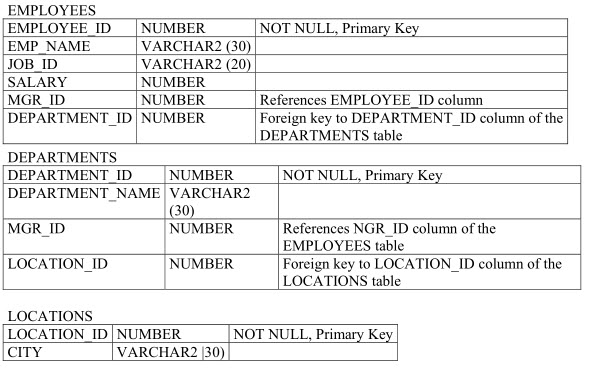
Which two SQL statements produce the name, department name, and the city of all the employees who earn more then 10000?()
Examine the data of the EMPLOYEES table.
EMPLOYEES (EMPLOYEE_ID is the primary key. MGR_ID is the ID of managers and refers to the EMPLOYEE_ID)

Which statement lists the ID, name, and salary of the employee, and the ID and name of the employee's manager, for all the employees who have a manager and earn more than 4000?()
Examine the data in the EMPLOYEES and DEPARTMENTS tables.
EMPLOYEES
LAST_NAME DEPARTMENT_ID SALARY
Getz 10 3000
Davis 20 1500
Bill 20 2200
Davis 30 5000
Kochhar 5000
DEPARTMENTS
DEPARTMENT_ID DEPARTMENT_NAME
10 Sales
20 Marketing
30 Accounts
40 Administration
You want to retrieve all employees, whether or not they have matching departments in the departments table.
Which query would you use?()
Exhibit
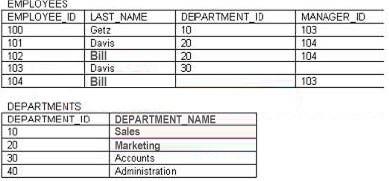
Examine the data in the EMPLOYEES and DEPARTMENTS tables.
You want to retrieve all employees' last names, along with their manager's last names and their department names. Which query would you use?()
Click the Exhibit button and examine the data in the EMPLOYEES and DEPARTMENTS tables.
You want to retrieve all employees, whether or not they have matching departments in the departments table. Which query would you use?()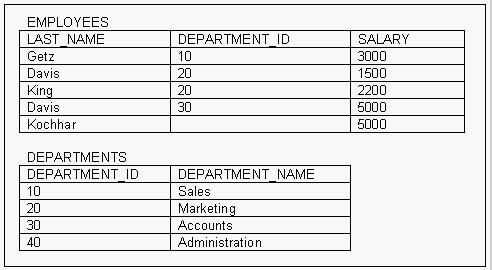
Examine the structure of the EMPLOYEES and NEW_EMPLOYEES tables: EMPLOYEES
EMPLOYEE_ID NUMBER Primary Key
FIRST_NAME VARCHAR2 (25)
LAST_NAME VARCHAR2 (25)
HIRE_DATE DATE
NEW EMPLOYEES
EMPLOYEE_ID NUMBER Primary Key
NAME VARCHAR2 (60)
Which DELETE statement is valid? ()
Examine the structure of the EMPLOYEES and NEW_EMPLOYEES tables:
EMPLOYEES
EMPLOYEE_ID NUMBER Primary Key
FIRST_NAME VARCHAR2(25)
LAST_NAME VARCHAR2(25)
HIRE_DATE DATE
NEW_EMPLOYEES
EMPLOYEE_ID NUMBER Primary Key
NAME VARCHAR2 (60)
Which DELETE statement is valid?()
Examine the structure of the EMPLOYEES and NEW_EMPLOYEES tables:
EMPLOYEES
EMPLOYEE_ID NUMBER Primary Key
FIRST_NAME VARCHAR2(25)
LAST_NAME VARCHAR2(25)
HIRE_DATE DATE
NEW_EMPLOYEES
EMPLOYEE_ID NUMBER Primary Key
NAME VARCHAR2(60)
Which UPDATE statement is valid?()
 Which two SQL statements produce the name, department name, and the city of all the employees who earn more then 10000?()
Which two SQL statements produce the name, department name, and the city of all the employees who earn more then 10000?()
免费的网站请分享给朋友吧